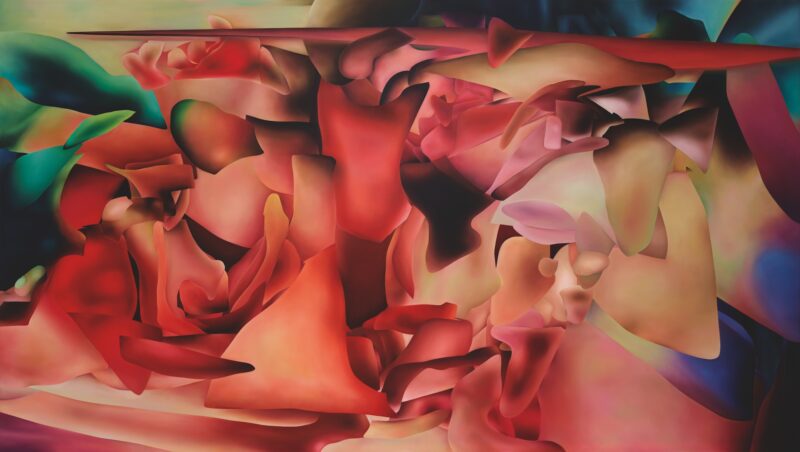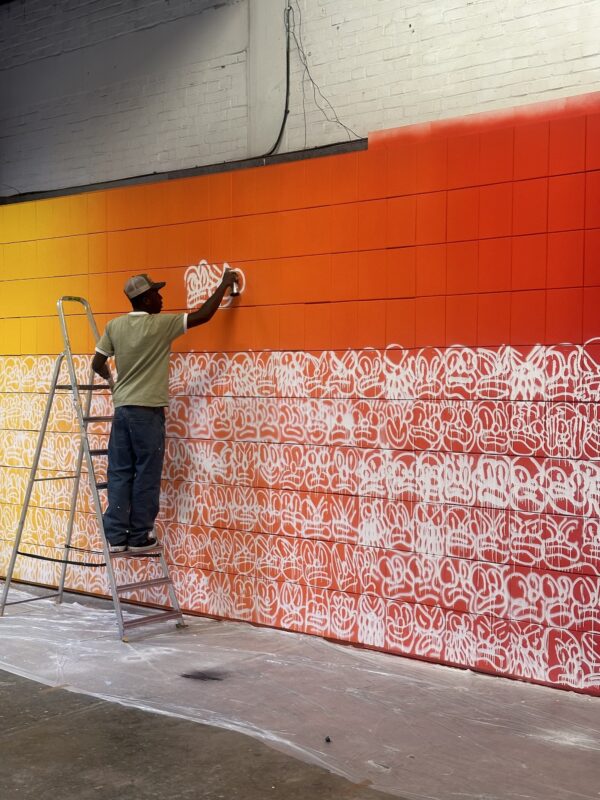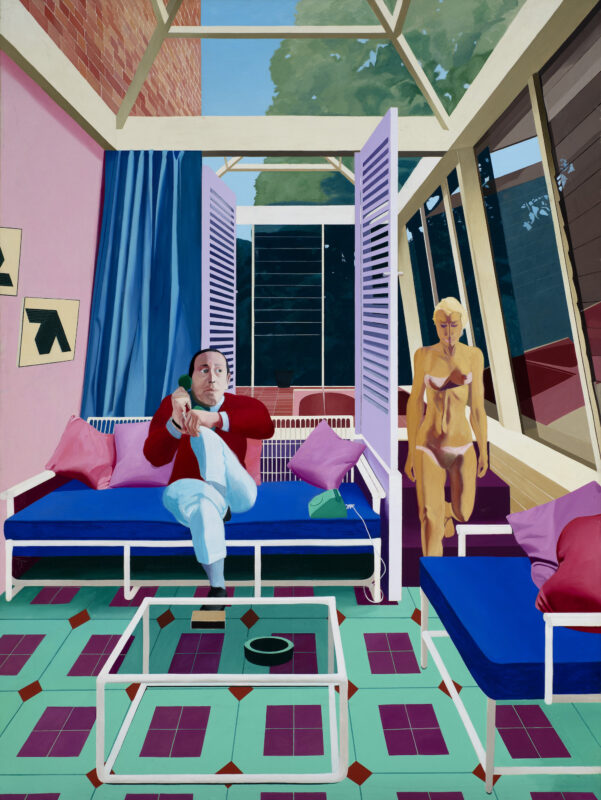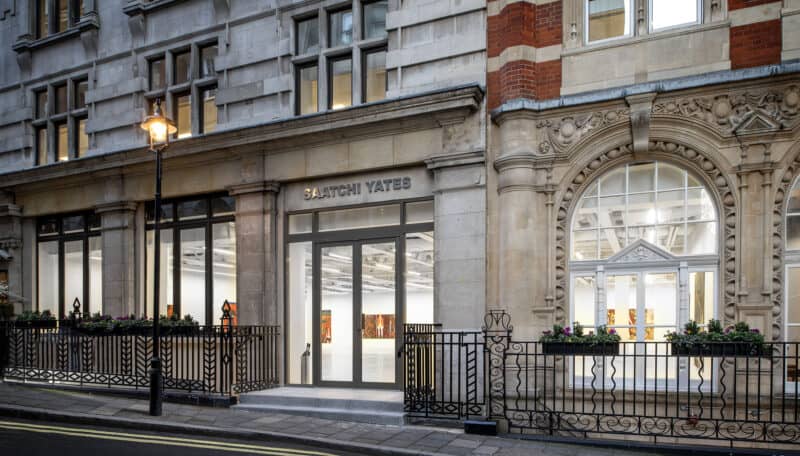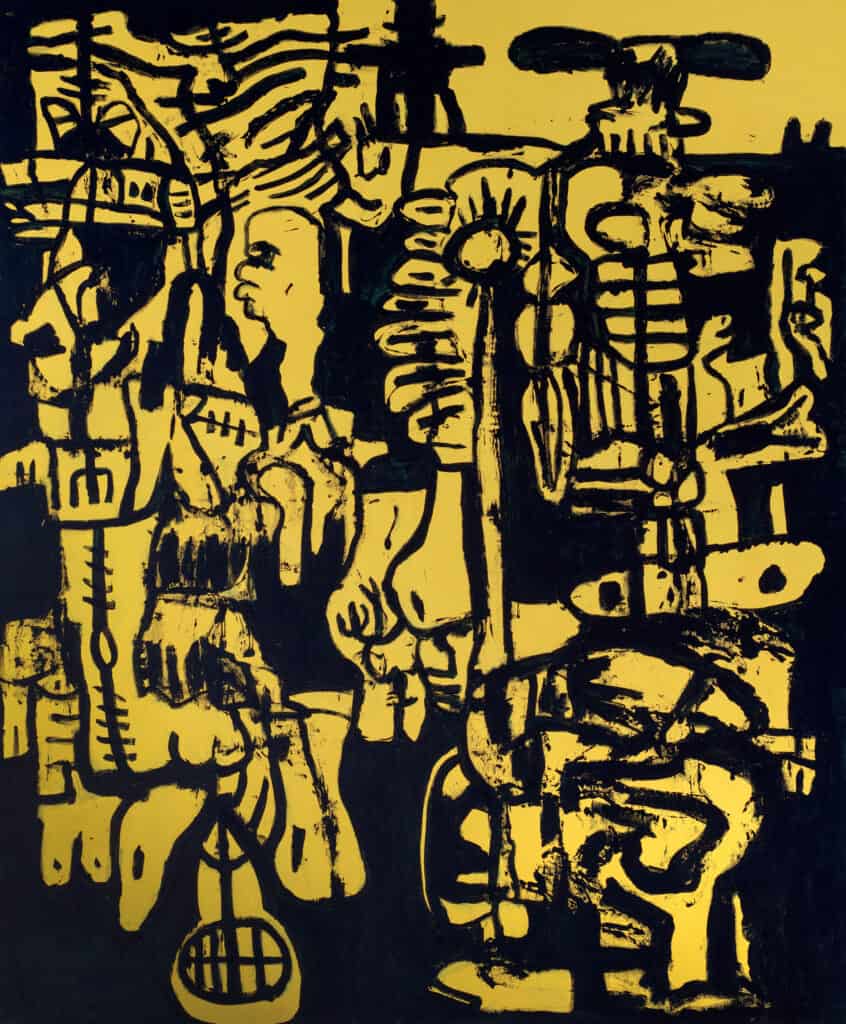
Currently hosting a solo show at Saatchi Yates, Kottie Paloma has burst onto the London art scene with his commanding, chaotic and cutting-edge canvases. Saatchi Yates is known for their exceptional ability to spotlight international talents worth serious recognition, and Paloma is no exception.
Born in the 70s, he grew up in Huntington Beach surrounded by the Punk, Skate, and Surfing scenes. He lived a self-proclaimed risky lifestyle, scrapping together the funds to buy art supplies in the form of Household paint and Butchers paper. A sense of mess, anarchy and rebellion, intrinsic to the darker corners of society, radiates from his canvases. They bring together desperate bodies, forms and objects into assemblages that crawl around the frame in a humorous yet menacing shuffle. A new aspect to his practice, large scale nudes, feel very grounded and authentic. They sidestep notions surrounding beauty standards and the politics of picturing women, instead reading as depictions akin to cave paintings. They are odes to women as goddesses, witches and rebels, without any sense of an underlying sexualising intent.
He has now settled into a quiet life in Alzenau, Germany with his family. He spends almost every day working away in the studio, often with his children by his side. Though, I sense a yearning for the metropolitan remains and is perhaps expressed in his neo-apocalyptic compositions. They take a round-about route to relaying disaster-driven news stories and capture, with ease, the anxiety of modern life and the washing machine brain of worries many of us live with day to day.
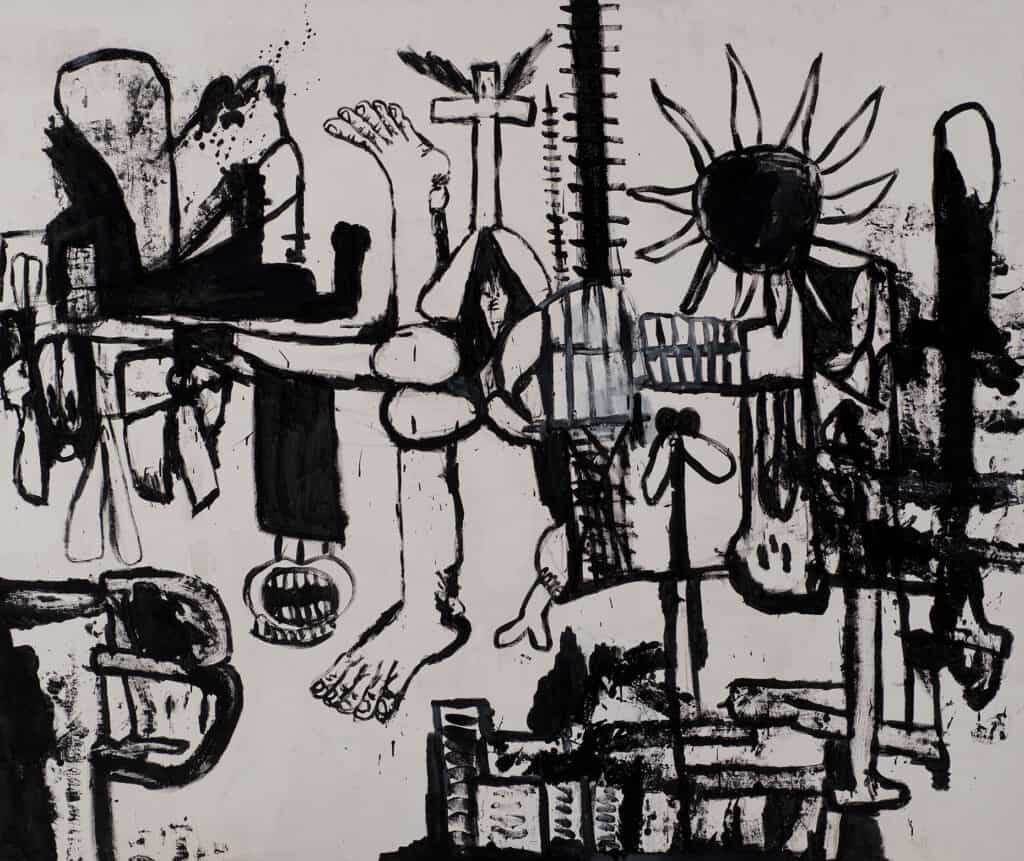
Tell us about your current show at Saatchi Yates, what are the main inspirations and what can people expect from the show?
I would like to start off by saying a huge thanks to Arthur, Phoebe, and the entire staff at Saatchi Yates. They did a beautiful job curating the show and they produced a really elegant catalogue too. The works span from 2019 to 2022 with the figurative paintings being some of the newest paintings I produced. The works were made in Los Angeles in 2019 and 2020 and in my new residence of Alzenau, Germany, a little wine village 30 minutes south east from Frankfurt in 2021 and 2022.
All of the paintings in the show were painted with just two colours. A foreground and a background. The works were inspired by current events, social issues, cave painting, abstraction, and figurative painting. I like the idea of art that looks like it’s gone to battle or dragged through the mud. It’s a well curated exhibit of my thoughts about the world from working in Los Angeles to Germany. The paintings are a bit dark in nature. For twenty years I have been inspired by taking dark ideas or tragedies and flipping them into something comical, dumb, or sarcastic.
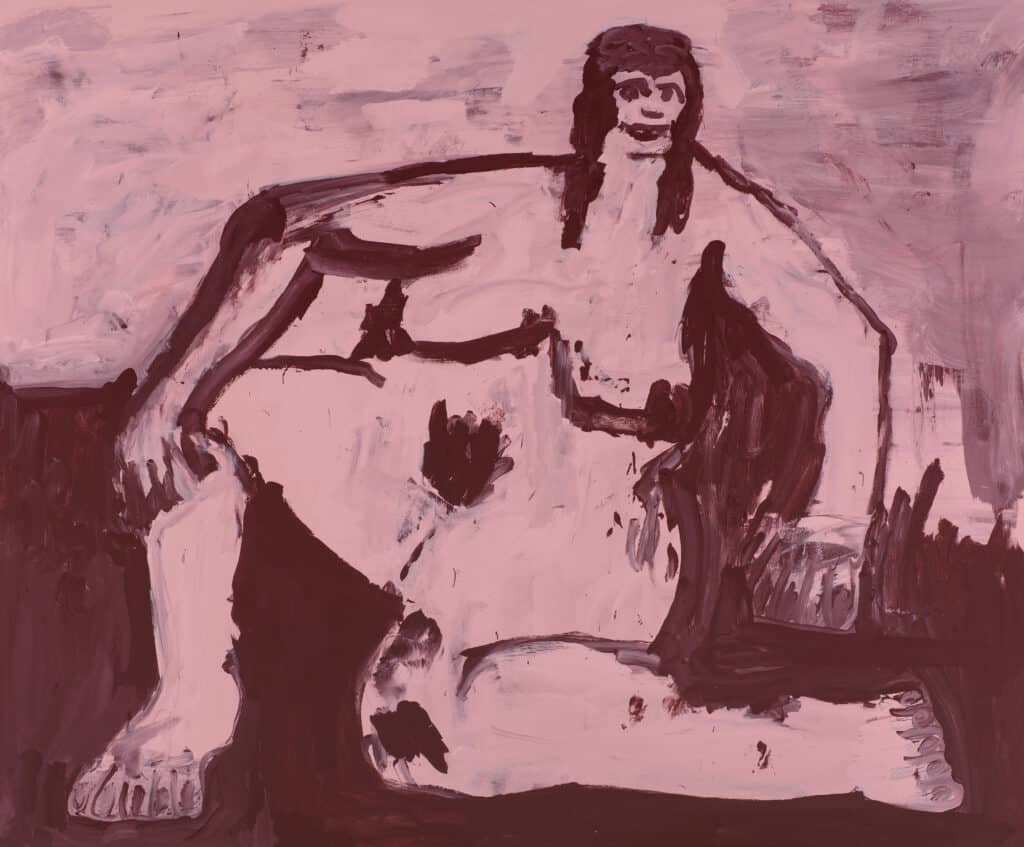
You have lived in a number of places including Los Angeles, San Francisco, Berlin, and Brooklyn, and are currently based in Alzenau, Germany; how have these desperate places influenced your work? There’s something about it that leads me to think of Skate culture in Los Angeles and San Francisco, is this something that influenced you?
I think art is regional. Definitely San Francisco and LA have that skate culture thing going on, but I always tried to steer clear of that scene even if it looks like my art is influenced by it. I mean, at my age 47, born in 1974, I grew up with that culture, so it’s part of me no matter what. Growing up in Huntington Beach in the 80s with Punk, Skate, and Surfing there wasn’t really any escaping that scene.
My San Francisco experience was just a giant party for 13 years, was a great place to learn about art and to experiment. But there’s no money for art in San Francisco. The tech industry destroyed everything artsy and cool about that city. They came and destroyed. Los Angeles is still the wild west of the art world. You can be any kind of artist there without feeling the need to fit your art into any kind of prescribed LA box. It’s a great place to be an artist. But unfortunately fake it till you make it is still heavily practiced there. Most of the artists I met there are super cool and generous people. There’s quite a lovely community of artists and it’s easy to make friends in LA. In Los Angeles I worked for a few different friends’ companies as an art installer for my day job handling celebrity accounts. It was quite common for me to go from like JZ and Beyonce’s house in the morning then to one of the Kardashians after lunch to hang their art collections. It was a weird but fun and insightful experience into that kind of celebrity world. Seeing and handling these peoples’ collections and being in these crazy LA homes was oddly inspiring in the fact that it lit a fire under my ass to get my career going quicker. I didn’t want to be the guy hanging the art in these celebrities’ houses; I wanted my art on those walls.
Brooklyn was fun and exciting and I felt the art scene was very open to new ideas. I felt like Berlin was too closed off, it was the first place I lived where it was difficult for me to make new friends quickly in the art scene. Americans stick with Americans, Canadians with Canadians, and the Australians with Australians etc. Most my friends in Berlin were either German or from elsewhere around the world and weren’t artists except for my studio mates, but everyone is broke in Berlin and I found it difficult to exhibit my art there.
Now I am in Alzenau, Germany, a small wine village of like 19,000 people. My brother in law was the mayor here for the last 8 years, now he’s the county supervisor for our region. It’s the birth place of my wife. It’s perfect for our two kids, but boring as hell for my wife and me, but that keeps me in the studio 6 days a week. We’re looking to move to a larger city, just not sure where to move to, looking into Vienna now, but who know, it’s my personal “Problem Nomadic”.
Music is an inspiration to you, how does this manifest? Do you work to music or is it more about the culture that surrounds it?
I consider music as the greatest short story or a narrative to listen to. I find it to be the most insightful window into the human psyche. I pull a lot of inspiration from music. I come up with my titles easier when listening to music.
In the studio, I usually spend the morning listening to the news, getting themes on current events etc for painting fodder. Then in the afternoon, once I start to paint, I switch to music. Sometimes, music can dictate which direction my compositions will go. If it’s a new song or a band I like with a new album, it’s fun to shape my composition around a sound I am listening to for the first time.
You work in thickly applied impasto paint, restricting yourself largely to two colours. What’s your relationship like with materials? Historically you worked with ‘oops’ paint on butcher paper, right? Do these materials still feature?
When I moved to Los Angeles in 2016 money was tight so I started a series of black paint drawings on butcher paper. The paper was I think like, 36 inches wide or something, so I would roll out two equal lengths of paper and glue them together to create a larger format to work on. Butcher paper is affordable and it can be durable to work with. I made around 48 of these drawings which in hindsight I realize now would be the precursor to what I am doing now. After those drawings I moved back to working on canvas, canvas drop cloths actually. Drop cloths are affordable and have sort of an art history to them, and when you buy the big package at the Home Depot, you can cut the drop cloth in half and get two nice large paintings out of it.
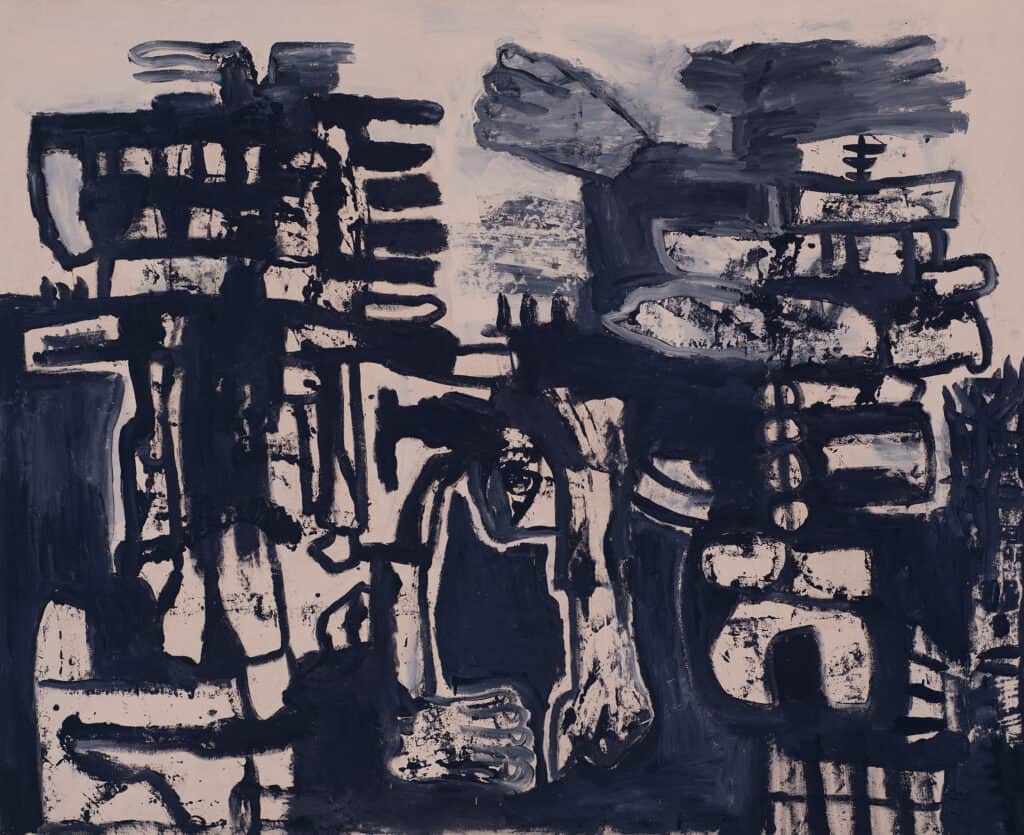
I used the “OOOPS” paint (coloured house paint that the customer rejected for one reason or another and marked down in price.) So instead of the store charging $60.00 for the gallon of house paint, they would charge $9.00. So, my relationship to these materials at the time was one of a financial relationship. Then, I researched the quality of the house paints and discovered they have the same lightfast or better than the expensive plasticky art store acrylics. The house paint is designed to withstand heavy sunlight, kids dirty finger prints that can be scrubbed off with a sponge, so I felt more comfortable knowing this and went full force with that as my main medium for paint. The house paint is very fluid but thick and if I applied the paint too thickly on the canvas, I would then use scraps of butcher paper to press onto the painting to pull off the excess paint. Sometimes, in doing this it would leave a nice print on the paper that I could then press back onto the painting and get a sort of monoprint in that section of the canvas. I liked this process so much I made it part of my technique in painting. In this process, I felt it worked best with only using two colours. Again, because of my finances at the time, I could keep my production costs down as well. It was as if due to being a broke artist, I somehow tapped into a part of the universe that took me by the hand and guided me to what I am doing now. I think if it weren’t for those dark broke days, I wouldn’t have discovered to do what I am doing now. Also, I learned through this process, that by using just two colours, I could eliminate any unnecessary vocabulary in the painting. Sort of an American goodbye, rather than a long German goodbye hahaha.
Now that I am in Germany, I don’t use that kind of paint or canvas anymore. The quality of house paint in Germany is too chalky, it cracks, so I luckily found an art store brand of acrylic that when dries has the same vibe as the American house paints. Also, I order my canvases stretched and ready go on aluminium frames from Artel in Holland. I still use the butcher paper but only for pressing or pulling paint on or off the canvas. When those pressings are done, I create large collages on paper from those pressings.
I would say there are two distinct areas of exploration in this show, a fleshy, heavy, and yet sparse atypical exploration of the female nude, and the graphic, busy paintings which seem to blend human, machine, quotidian object, and more into a monumental assemblage. How do these sides of your practice speak to one another?
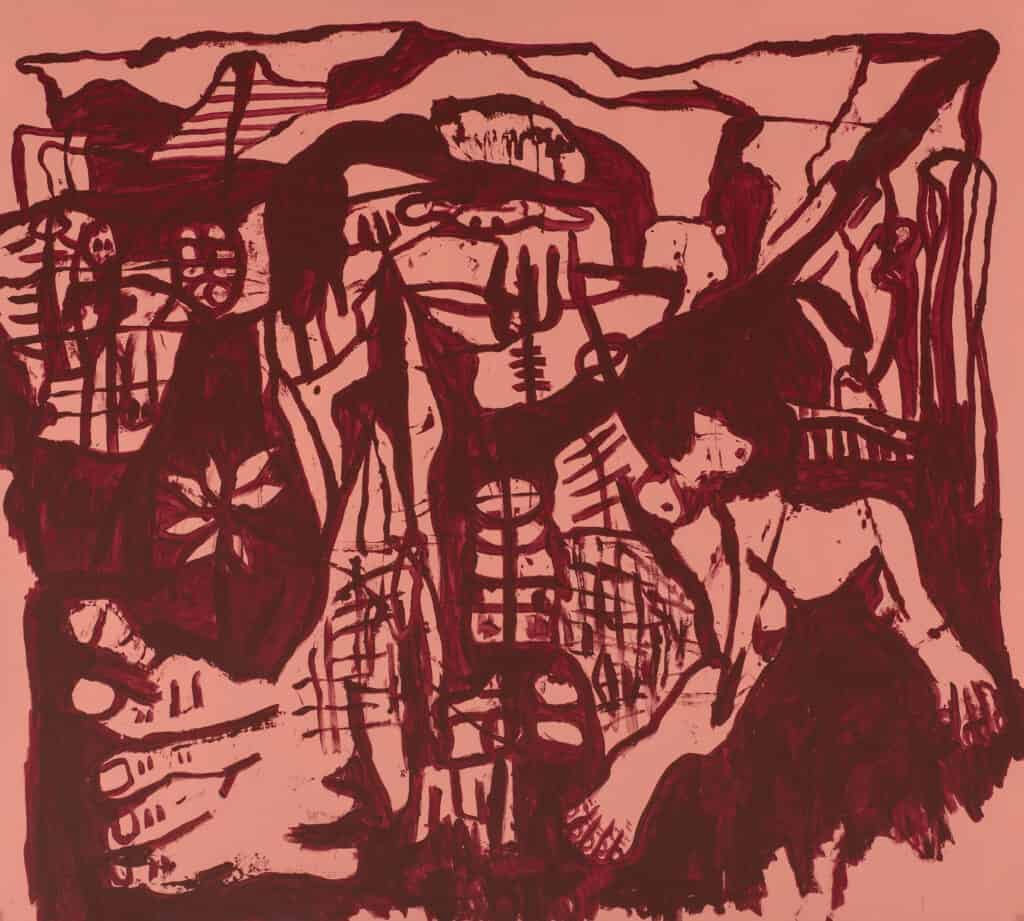
The nudes are a new thing for me. I’ve always wanted to make figurative painting but just couldn’t find my voice in it till now. In the past I felt like if I did figurative painting it needed to be pretty or flattering. But pretty and flattering isn’t how I see art for myself. So last December I experimented for a few weeks with this form and quickly loved how I was making these paintings. Using the same idea of just two muted colours and placing the figure in mud seemed to make sense to me.
At first glance they are obviously different than the other paintings but carry the same heavy theme as the others but in a singular aspect as opposed to combining different symbols to create a picture. They are also my way of making a pun on the classical nude or what society pushes as beauty. To me, even in the roughness, these are beautiful women. Earthy women that can be mothers, psychics, witches, refugees, or heroes. The other paintings, the busier ones, allow me a freedom to combine multiple ideas or imagery I have floating in my head to marry them into one picture. These abstracty/figurative or representational paintings allow me to work to create multiple narratives within one narrative. Sort of like creating multiple universes within one universe.
I have to ask, what is it about feet – they seem to pop up everywhere in a comic yet almost grotesque manner in your paintings.
The foot is a symbol I have been working with since around 2005. In the beginning I was just trying to draw or paint a foot without any kind of meaning. I liked the way I drew the foot, people thought it was strange and comical so I kept using it.
Now the foot has several meanings to me. It’s what we walk on; there are people with weird foot fetishes, the idea of one foot in, one foot out. It’s in a way my idea of fence sitters, or if I have one foot up and one foot down on the same leg, it can be my way of using the Yin and Yang idea. What’s up is down and vice versa. It also can symbolize a collapse or a life journey. It all depends on the context within the painting. Some artists use flowers or skulls, I use the foot. It’s like my pink to Guston’s red or Picasso’s blues.
In what ways do you seek to explore a darker side of society in your work? There’s something very brutal and gritty about it, almost frightening.
I grew up in a very Christian religious family. Since I was around the age of four years old there were always heavy dinner conversations about the end of the world or end time prophecies. It seemed normal to me to have these conversations with my parents or grandparents. It definitely shaped my world view in a way. Though I fell out of the church at a relatively young age, these early conversations always stuck with me, kind of gave me strange symbols to look out for.
I admit, in my twenties and thirties in San Francisco, I lived a very wild life style. I somehow found myself in strange and many times extremely dangerous situations and somehow, I always survived with just a headache. Also growing up in a sort of punk rock world, many bands like Black Flag, Cro-Mags, Bad Brains, or Suicidal Tendencies to name a few sang about these sorts of themes. I feel like my conversations with my parents, and listening to these bands when I got older and discovered punk either helped or hurt my world view.
Back in my twenties and thirties I was living under the notion if you’re gonna make narrative art or do any kind of story telling then you need to know the subject matter extremely well, which to me meant living in those strange situations; and some of those situations were very dark yet eye opening as to how the world works.
Growing up as a small and skinny kid, I got picked on a lot by bigger kids and had to learn how to throw a punch at an early age. This kind of gave me the confidence to defend myself later in life when I found myself going down a dark unknown road. I think that all my weirdo past experiences gave me enough insight and the tools I need to peel back the onion of the world and be able to paint about various aspects of society. Now I just look at the news and have discussions with my friends about current events, I don’t need to live the rough and dark experiences anymore to be able to paint how I paint.
The chaos, injustice, and complexity of the modern society we inhabit comes through poignantly in the muddle and anarchy of your paintings – they feel to me like a modern Guernica, capturing the battles of contemporary urban capitalism. What are you seeking to get at in terms of commentary and critique around these ideas? Does this ring true of your approach?
I think modern life, even with our luxuries of accessibilities to things like products through Amazon and flushing toilets is still a struggle and can be brutal. This divide between wealth and poverty is so morally egregious. Constant wars that tear people apart but make politicians, bankers, and manufacturers rich is morally wrong and evil in mine and most normal people’s views, but it still goes on as if that machine is too big to destroy.
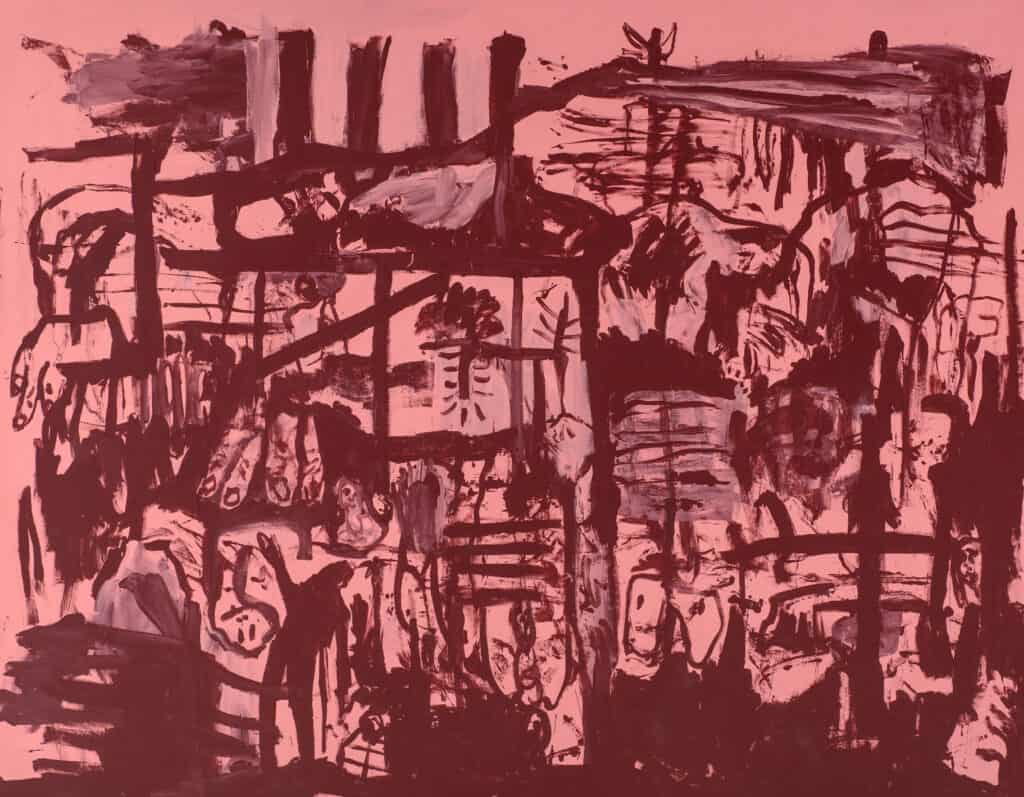
In America, there’s a television in many restaurants and bars either showing sports or CNN, or something like FOX News promoting fear to the society. This really took off in a huge way after 911. Sports to keep you dumb and entertained, and the news to keep you in fear. I don’t remember this being the case before 911 and George Bush’s terror, and it still continues with COVID-19 and now the war in Ukraine. It’s constantly in your face and difficult to escape it. And I don’t think escapism is the answer to art all of the time. How can a serious artist seriously paint living room settings with books depicting their favourite artists piled on a table with roses in a time like this? I can see that I can take shit for that last comment, but that comment holds true for me. I guess what I am getting at is art like mine can be used to talk about darker aspects of society; it can highlight what most people want to sweep under the rug.
Visit Kottie Paloma’s solo exhibition at Saatchi Yates, Cork Street (Until 22 May 2022)Find out more: saatchiyates.com | @saatchiyates | @kottiepaloma |
